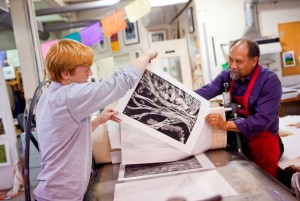
Curlee Holton works with a student in the Experimental Printmaking Institute.
Growing up, Curlee Raven Holton always admired his older brother Homer’s drawings and tried to follow in his footsteps. It wasn’t until college that he truly understood the impact art can have in everyday life. A business major at the time, he witnessed a horrific car accident.
“A car hit a young man riding a bicycle. I did a drawing of the accident and later was contacted by a lawyer who had heard that an artist had done a drawing,” recalls Holton, who earned his M.F.A. at Kent State University. “The drawing was introduced in court as evidence. I knew then that art could be very powerful.”
Now a successful international artist, Holton continues making connections with people through his work. Some of the greatest compliments he receives are from viewers expressing how his work has touched them.
Creating a place for student artists to express themselves and mingle with artists from all different backgrounds is paramount for Holton as director of Lafayette’s Experimental Printmaking Institute (EPI). He founded EPI in 1996 to promote research and experimentation within the print medium. Since EPI’s inception, the visiting artist and artist-in-residence programs have inspired print editions, experimental works, and artists’ books, which have been included in galleries and exhibits around the globe.
“I established EPI as a way to create a living classroom that embraces diversity, creativity, and collaboration,” he says. “We all have something special to bring to the table, and when we collaborate, what comes out is almost always better than what we do alone. The creative classroom experience offers the rarest of educational opportunities and value to our students, and the living knowledge that artists have acquired is invaluable to this process.”
Among the artists hosted at EPI are some of America’s most acclaimed such as Faith Ringgold, Richard Anuskiwicz, David Driskell, Grace Hartigan, and Sam Gilliam. Students collaborate with Holton and these visiting artists, with the support of patrons and Lafayette College, in a unique printmaking laboratory to create museum-quality pieces included in collections such as the Metropolitan Museum of Art as well as within the permanent collections of various colleges and universities.
Holton says seeing a student’s pride in his or her work is one of the highlights of his teaching career. One student worked with Ringgold on the print “Under a Blood Red Sky,” which became the top-selling print at the Metropolitan Museum of Art. Exposing students to celebrated, working artists shows them what is possible in the world of creativity. A working artist himself, Holton brings his rich experience to the classroom every day and draws inspiration from his students.
“It allows me to teach from a place of lived experience,” he explains. “It allows me to mentor a student in real-world experiences rather than in conceptual or popular ideas of what an artist is and what life they live. Students are amazed when they read about a famous artist and see my name mentioned or know that I am friends with so many successful artists. They are learning by practice rather than by a text. Students often influence my work by their unique approaches to problem solving and personal experiences that are different from my own.”
Last year, Holton was appointed to a newly endowed chair, becoming the David M. ’70 and Linda Roth Professor of Art. The College has also recognized him for excellence in teaching and research with the Carl R. and Ingeborg Beidleman Research Award, the James E. Lennertz Award, and a Marquis Teaching Award.
Holton’s prints and paintings have been exhibited professionally in more than 40 one-person shows and more than 100 group shows, including prestigious national and international venues such as Egypt’s International Biennale; Taller de arts Plasticas Rufino Tamayo in Oaxaca, Mexico; Casa de la Cultura de Azcapotzalco (The House of Culture) in Mexico City; the Cleveland Museum of Art; and the Whitney Museum of American Art.
His work is in the Chemistry of Color: The Sorgenti Collection of Contemporary African–American Art exhibit at the Hudson River Museum in Yonkers, N.Y., through May 8 and an exhibit at the Tubman African American Museum in Macon, Ga., through April 2.
His art is also in many private and public collections, including the Cleveland Museum of Art; the West Virginia Governor’s Mansion; Foundation of Culture Rodolfo Morales in Oaxaca, Mexico; Yale University Art Gallery; the Pennsylvania Academy of the Fine Arts; and the Library of Congress.
Crossing cultural boundaries continues to be one of the most rewarding aspects of his career.
“When my work is appreciated and collected in a foreign country where I can’t even speak the language, it is the highest compliment that it can transcend racial, ethnic, cultural, and social differences,” he says.
